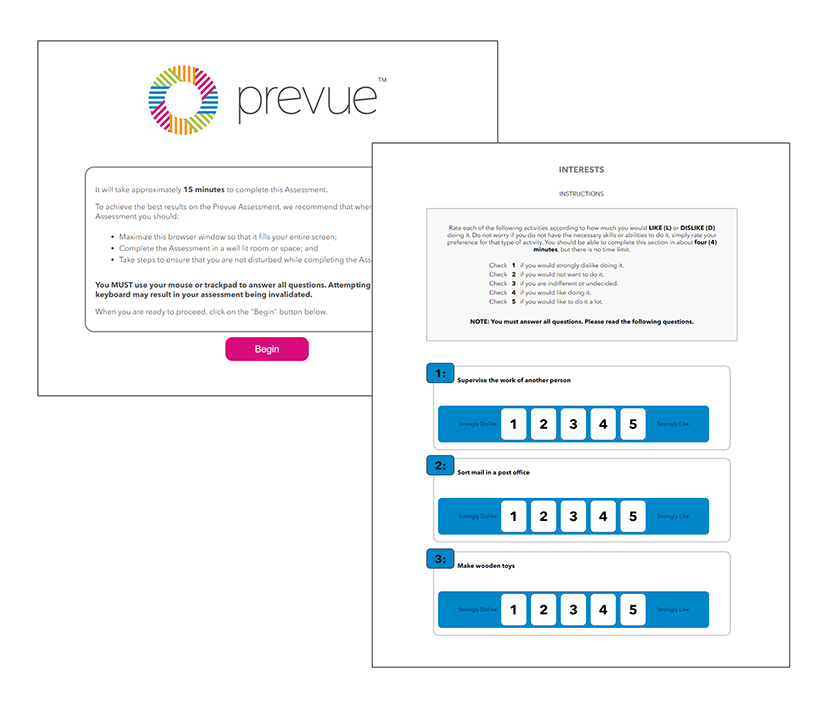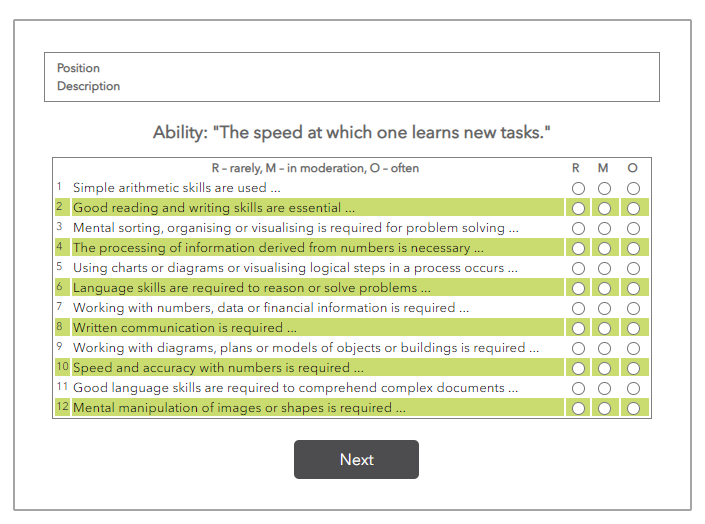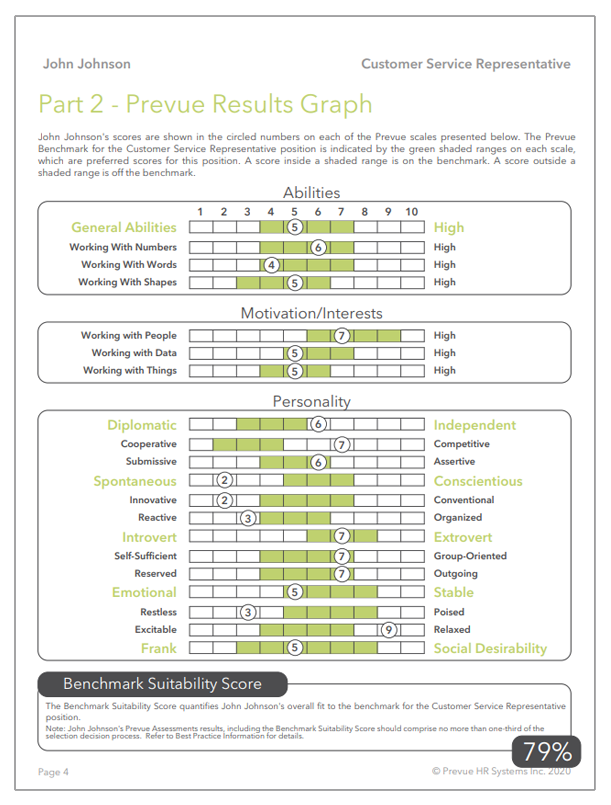Introduction

What to expect
You’ve taken the first step. You’ve come to the decision that you want to start using a pre-employment assessment tool to help you find better hires. However, when you search online, you find a dozen different companies that offers various hiring tools. How should you pick?
To save you some time, our team at Prevue has prepared a series of side-by-side comparisons to help you find the best hiring assessment tool for your company. We are very proud of our product, but our goal is to give you an unbiased and honest full picture of the products. We hope this will help!
Introduction
Compare the following:
- What does our assessments measure? How are they conducted?
- What standard of measure is used behind the assessments? How are benchmarks created?
- What is included in the reports? How are they presented?
- What kind of customer support do you provide? Is there training available?
What does our assessments measure? How are they conducted?
 Prevue: As with most sciences, the method and models behind pre-employment assessments are standardized to ensure reliability, validity, and fairness. Prevue’s Assessment Suite doesn’t miss a beat – it uses relevant science to measure a candidate’s cognitive aptitude, personality, and motivations. To get the full picture of job preference and fit, you’ll want to test for all three.
Prevue: As with most sciences, the method and models behind pre-employment assessments are standardized to ensure reliability, validity, and fairness. Prevue’s Assessment Suite doesn’t miss a beat – it uses relevant science to measure a candidate’s cognitive aptitude, personality, and motivations. To get the full picture of job preference and fit, you’ll want to test for all three.
In a sea of assessment providers who basically offer the very same type of hiring solutions, at Prevue, we distinguish ourselves by being simple and straightforward. Through years of research, we managed to create a multi-use assessment without missing any of the scientific elements that go into predicting job-fit. This means every candidate completes the same 35-minute assessment and will be evaluated fairly, and equally, across any position.
While we encourage our customers to utilize the full assessment for hiring the best, we also recommend combinations of assessment sections for different purposes. For example, you can test a candidate on their learning and reasoning by giving them only the Aptitude part of the assessment. Or, when hiring for positions that primarily deal with numbers on the fly, we have a Numerical Reasoning assessment that covers just numbers, motivations, and personality. This option saves you time and gives candidates an experience that speaks precisely to their skills.
HighMatch: Very similarly, HighMatch’s assessment covers two core components: personality and problem-solving skills – the latter which, according to them, are indicators of a candidate’s cognitive abilities and intelligence. A big pro of measuring problem-solving traits is that it helps identify if someone is a critical thinker or a multi-tasker. In addition to specific questions on vocabulary and shape manipulation, which can also be found in our Prevue aptitude assessment, HighMatch includes logic puzzles aimed at testing a candidate’s general intelligence.
What else? The team at HighMatch knows exactly how to attract assessment users by offering the option to custom select what they would like to measure in a test – whether that be personality only or a combination of problem-solving and integrity. Hence, depending on your requirements, the length of each assessment can vary from 10 to 60 minutes.
Comparison: Prevue’s strength lies in making complex data simple; our goal was to create a standard solution that is easy to understand and use for all sorts of job candidates. Meanwhile, HighMatch gives its customers more flexibility over the time it takes to complete the assessments by giving them the option to mix and match test components outside of the given presets.
The key differentiator, though, is our Motivations/Interests assessment. At Prevue, we dedicate a separate section to a candidate’s job interests. How likely are they going to be motivated and satisfied to stay in the job long term? What makes them tick? We stand by the belief that a job should be more than “just a paycheck”. By considering the candidate’s motivations, we ensure that the job-candidate match is a true reflection of what we call “job-fit”. This gives Prevue a greater edge here.
Results: HighMatch wins for time savings. HighMatch’s ability to choose what to assess allows for potential time savings for the candidate. On the other hand, while Prevue’s thorough assessment approach reaches closer to what it means by hiring the best fit, the full assessment could take longer to complete.
What standard of measure is used behind the assessments? How are benchmarks created?
Prevue: We’ve invested a lot of time developing our assessments in a way that is simple and scientifically rooted. This includes working with renowned occupational psychologists – some of whom you may recognize such as Dr. David Bartram and Dr. Pat Lindley. Over the years, our team of in-house psychometricians continue to research and review our hiring tools to ensure that they reflect our current work climate.
At Prevue, we stand out by offering customizable job profiles – we call them “benchmarks” – that directly echo your company’s hiring needs. Whether you’re looking for a salesperson who is confident in speech and abundantly ambitious, or an accountant who needs to be well-organized and detailed, we have the science to help map out the ideal qualities needed for the role.
We build our benchmarks in several ways: A Job Description Survey, Top-Performer Study, or a combination that will give you all the data needed to put together the best employee profile; we also have a general Benchmark Library for those who want to save time and get started as soon as possible. Because Prevue is all about making hiring science easy and accessible for everyone, we make sure the process in building a benchmark is thorough yet simple. So expect to complete a short 10-minute survey or invite your star players to complete an assessment, and our team will do the rest of the heavy lifting.
HighMatch: An assessment has to be fair, reliable, and valid to be considered effective. HighMatch ensures this by conducting over 500 validation studies in order to provide an unbiased perspective on how a candidate may fit into your company and your job.
Like Prevue, HighMatch also understands the importance of having customized hiring profiles for each role. They do this by inviting existing team members from your company, including your most effective and least effective workers, to complete an assessment – a slight difference from Prevue’s Top Performer Study that involves only your best employees. Beyond identifying traits that your top performers have in common, by using data they have on lower-performing staff, you’ll get to find out what sets your star players apart from everyone else. HighMatch shows you not only who to hire next – but also who to avoid.
 Comparison: If replicating top performers was the only category, Prevue and HighMatch would have both taken the lead in the competition. But a good fit is more than someone who can ace the job. In any workplace, employees whose values and preferences align with the company’s are more likely to perform better and be satisfied with their job. This is what we call – culture fit.
Comparison: If replicating top performers was the only category, Prevue and HighMatch would have both taken the lead in the competition. But a good fit is more than someone who can ace the job. In any workplace, employees whose values and preferences align with the company’s are more likely to perform better and be satisfied with their job. This is what we call – culture fit.
HighMatch measures this by having managers rate their employees as part of their top performer study. For example, workers given a three-stars rating (out of three) are considered high-performing members – meaning they possess qualities that leaders may want to foster in the company. Likewise, results from one-star employees can be used to determine traits to avoid in your next hiring.
At Prevue, we involve managers in a different way by inviting them to complete a short yet descriptive questionnaire – drawing insights directly from your company’s unique needs and culture. Though separate from our Top Performer Study, we have the science to combine data from both methods to create a comprehensive benchmark in one place.
Results: Prevue wins by a small margin. While both teams are winners for having customized benchmarks, the fact that Prevue lets you choose what you value in a candidate regardless of how your current employees are performing (via the Job Description Survey) means you get to pick out qualities that perhaps your best performers to date don’t possess yet.
What is included in the reports? How are they presented?
 Prevue: Aiming for the fine balance between being straightforward and having a comprehensive result, our Prevue Job-Fit report has one standardized format. Along with the customizable benchmarks and the shared core assessment, by using the same report format, you’ll be able to compare your candidates to different job positions that may be a better fit, or use it in succession planning for future job growth.
Prevue: Aiming for the fine balance between being straightforward and having a comprehensive result, our Prevue Job-Fit report has one standardized format. Along with the customizable benchmarks and the shared core assessment, by using the same report format, you’ll be able to compare your candidates to different job positions that may be a better fit, or use it in succession planning for future job growth.
Our report is divided into several parts. You’ll find a Prevue Results Graph comparing the candidate’s assessment results to the job-fit profile you have customized for the role. The suitability score in the report comes from a formula that analyzes the areas where the candidate has landed (or not landed) on the benchmark – meaning the higher the score, the better match they are with the job.
We complement these findings by providing you an interview guide that targets areas off the benchmark. These suggested questions are designed to probe at how this may affect the candidate’s performance in the role, whether they are aware of their challenges, and provide an opportunity to describe how they may work to overcome it.
HighMatch: HighMatch similarly shares the idea of having an all-in-one job-fit report. This, of course, comes with a results chart and is complemented by an interview guide as well – which in HighMatch’s case, targets areas both on and off the benchmark.
We found out from the previous section that HighMatch invites managers to rate existing team members. Not only is this used to build unique hiring profiles; for its reports, the same data is used to rank key traits and behavior according to their importance to the job. In other words, if a trait’s impact on a job is low, it will have less effect on the candidate’s overall job-fit score.
A closer look at HighMatch’s results chart, you’ll also notice that scores aren’t given a numerical value. Instead, they’re expressed as a strong match, slight mismatch, or a significant mismatch – all depending on where they land on the benchmark.
Comparison: Prevue and HighMatch’s reports share a similar format in how we display our candidate data – starting with a benchmark comparison graph, a final score, and a follow-up interview guide. The main difference lies in the way our scores are calculated and presented.
At Prevue, we weigh every scale equally and we deduct marks from the final score only when the individual falls off the benchmark. HighMatch, on the other hand, rates each trait based on its importance to the job. This means even if a person scored poorly under low impact traits, but had strong matches for its higher impact traits, the candidate would likely still score well enough to be considered a good fit for the role.
We find HighMatch the better solution if you’re hiring niche roles with extreme qualities – for example, a mechanic whose structure and spatial visualization skills are valued to a much greater extent than traits such as assertiveness. However, in a more common work scenario where job functions may overlap, Prevue’s all-around approach allows you to evaluate candidates in a bigger picture, while reducing the likelihood of over-interpretation. Unless you’re a psychometrician, it’s probably best that users don’t over-analyze at such a granular level.
Results: A tie. What’s your no.1 goal when it comes to an assessment tool? If your answer is hiring the right specialists, then HighMatch is your winner with its in-depth analysis on candidate traits. If your answer is making quick and precise hiring decisions targeting well-rounded individuals, then turn to Prevue for more concise outputs that speak to both your job and your company’s culture.
What kind of customer support do you provide? Is there training available?
Prevue: Once you’re onboard at Prevue, you’ll be paired with a representative from our Success team who will act as your designated point of contact throughout your journey with us. We want to make sure that you make the most of what we have to offer. That is why through our different training and refresher sessions, we will cover everything you need to know at zero additional cost to get you going as soon as possible. Your Customer Success Manager will guide you through specific training on system setups, benchmark finalizations, and understanding our reports. Of course, as part of our ongoing support, your Success rep will continue to assist you with any concerns that you may come across. We are never more than a phone call or an email away, and we make this absolutely free for all our customers!
HighMatch: HighMatch’s how-to tutorials and videos are made accessible to all their clients on their Knowledge Base, so users can learn the ins and outs of every aspect of HighMatch at their own pace and time. Unlike Prevue, extra help from support teams and online trainings are available only to customers under their paid Professional and Enterprise plans.
Comparison: Prevue takes the ‘service’ in Software-as-a-Service (SAAS) very seriously. We have the objective in providing a seamless post-purchase experience to our customers, and we achieve this by offering free training and effective support so our customer’s goals can also be met. While person-to-person assistance comes with additional cost at HighMatch, it stands out with its thorough and free online guides on how to use their assessments, read reports, navigate their system, and much more. Can’t remember how to invite people to assessments? Get your answers through their Knowledge Base without delay.
Results: Prevue wins. Free and tailored support for teams of any size gives us more edge here.
This post was last edited on February 2, 2022 to reflect Berke’s new rebrand as HighMatch.



